Ikea in China: Store or theme park?
- Published
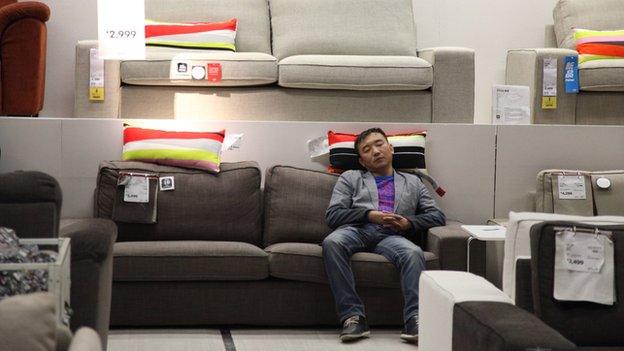
Ready…set… run! The doors have just opened at an Ikea furniture store in east Beijing. Even on a weekday morning, this store is packed.
In just a few minutes, customers spread out across every corner of the four-storey sales area. It's clear that most know the store well.
"This is a store of the people," smiles Tana, a 53-year-old university professor clutching a desk lamp in Ikea's lighting section. "They have all the things ordinary people use. Every time I come here, I stay for the whole day and have lunch here."
In China, Ikea isn't just a home furnishing depot - a place to buy what you need and leave. Many here treat it like a furniture-filled theme park, a place to spend hours taking every product for a spin.
"It takes me five or six hours to drive here and I'll stay for at least eight hours," explains Mr Han, a young man who drove here from Handan, a city in neighbouring Hebei province.
But the slog is worth it, he says. "I like how they give us the real experience of using their products."
There is no other store in China quite like Ikea, where customers are welcome to spend hours lounging on every sofa and bed in the store, or thoroughly testing the toys available in the children's section.
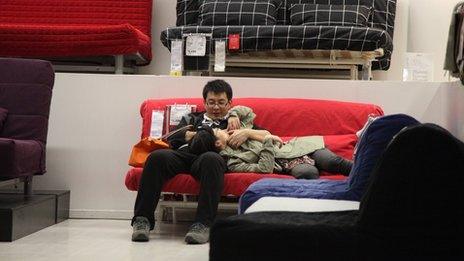
Ikea's sales model is based on the idea that customers should be able to try out everything in the store, including the sofas.
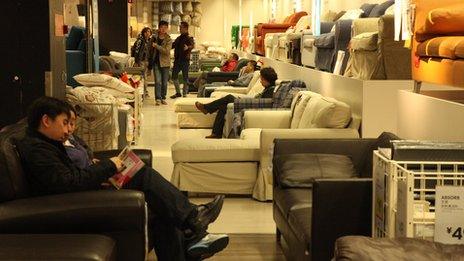
Some 15,000 pass through this store every weekday, with 25,000 or 30,000 at weekends and holidays. Angela Zhu, Ikea China's retail manager, says 5,000 people visit an average store in Germany each day and 10,000 at weekends.
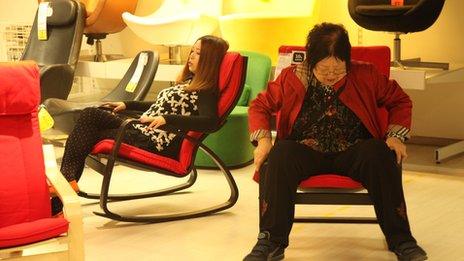
The Poang chair is considered an "entry-level" furniture item in China; a low-price item meant to convince new shoppers to purchase furniture.
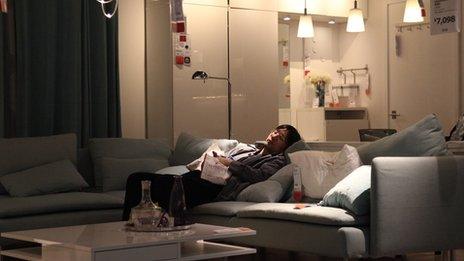
Ikea is planning to open three stores a year until 2020, many in second-tier Chinese cities like Chongqing, Xi'an and Qingdao.
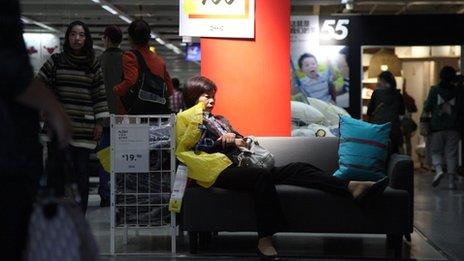
"Ideally, we want many people, in different age groups and in different living situations to shop with us," says Angela Zhu. "But in China, in reality, the typical customer is 25 to 45 age wise and the majority are females."
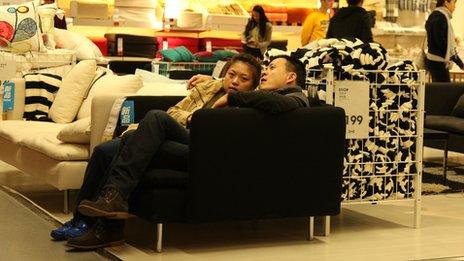
Many people treat a trip to Ikea as an all-day event that includes shopping, eating and relaxing. Ikea's Chinese locations contain more room displays than in other countries to accommodate shoppers who want to test their wares.
Ikea has its imitators in China. One furniture chain in Kunming, southern China, called 11 Furniture, has copied Ikea's sales model, from its blue tarp shopping bags to the Swedish-sounding names on its furniture information tags.
But 11 Furniture's scale doesn't compare to Ikea. The majority of Chinese stores simply don't have the floor space to allow their customers to thoroughly test out their wares.
It's also common for sales assistants in many Chinese furniture stores to earn part of their salaries on commission, making it difficult for them to adopt Ikea's wait-and-see attitude towards future sales.
Instead, Ikea has the space, and the capital to allow it to relax its policy on almost everything. This laissez-faire attitude has helped to make this store busy from morning until night.
'Too expensive'
At noon, the store's 700-seat cafeteria is full of customers eating Swedish meatballs, and Chinese cold spicy chicken. After that, many find a quiet part of the store to relax.
Watch: After years of struggling in China, the Swedish furniture giant Ikea is now making profits there at last as the BBC's Celia Hatton reports.
The sofa section is a particular favourite. People lounge on the furniture, some carrying out heartfelt conversations. Others zone out with their mobile phones.
In the bed section, one exhausted-looking mother paces with her young baby, trying to calm him before placing him for a nap on a display bedroom. She walks past customers who are tucked up in other beds, their shoes neatly lined up on the floor beside them.
Ikea's first stores in China couldn't accommodate all-day shoppers. But if they build huge stores, Ikea has now realised, the crowds will come. Forty-five million visitors passed through Ikea's China locations last year.
Eight of the ten biggest Ikea's in the world are now located in China. The super-sized outlets have extra-wide aisles, extra room displays and larger warehouses that help keep the store stocked with cash and carry items popular with first-time visitors.

Chinese Ikea outlets have 40% more customer traffic than in other countries, explains Ikea China's retail manager, Angela Zhu.
"This store, about 15,000 visitors on a weekday and on a weekend, 25,000 visitors to 30,000 visitors," she smiles.
Those who worry that Chinese shoppers are following their Western counterparts towards a lifestyle of consumerism may cringe, but Ikea is an interesting example of a Western store that has adapted to its Chinese environment.
Products have also been redesigned with Chinese customers in mind - little things, like deepening bowls so they can hold rice. Every store in China features mock-ups of the tiny apartments common in many Chinese cities, kitted out with Ikea products.
Crucially, prices were slashed by an average of 50% across the store, often by moving production inside China.
"When we came to market, we realised that our prices had been too expensive," explains Angela Zhu. "It took years for us to continuously reduce our retail prices, to really let many people afford them."
Ikea already has 13 stores, and from now on, it is set to open three stores a year in China, mostly in second-tier cities that have no experience with flat-pack furniture.
After years of lacklustre sales, Ikea's changes for the China market are finally starting to help the retailer to see growing profits. Sales are up 17% this year, making China one of the retailer's fastest growing markets.
Yes, Chinese people like to hang out at Ikea, but now they like to spend money there too.
- Published30 October 2012
- Published20 January 2012